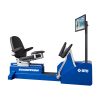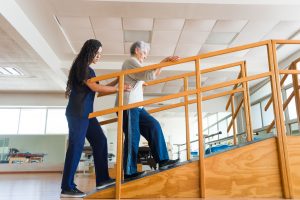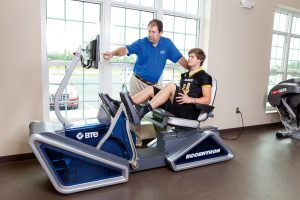
Better Fall Prevention Programs - With Eccentric Exercise
Treatment GuidelinesEccentric-only exercise can generate higher forces at higher intensities with lower energetic cost. This makes it ideal for elderly patients or those with low exercise tolerance. The low energetic cost means they can exercise with greater load on the muscles without straining the joints.
Due to physiological changes of both quantity and quality of skeletal muscle, the elderly are at a 10x higher risk of falling than other younger age groups (1, Miller, CA). As many as 50% of those over 65 will suffer at least one fall a year resulting in both short and long term physical disabilities. As age increases, so does the likelihood and frequency of falls. Fall related injuries cost the medical system as much as $30 billion according to CDC statistics. To combat the risk, many in this age range participate in group exercises as a way to slow down the aging process and decrease fall risks. It has been found, however, that more individualized programs specific to each person may be more beneficial (2, Skelton, DA).
Countless programs have been designed and implemented that encourage the aging population to get more active. In traditional programs, eccentric exercise is incorporated along with concentric exercise. The concentric exercise has an oxygen requirement and this can take away needed nutrients from an injured or healing area as well as reducing the work output for a given session. When one focuses exclusively on eccentric exercises, they are able to generate higher forces and at higher intensities at lower energetic costs, with lower perceived exertion levels (3, LaStayo et al). This allows for patients with various comorbidities such as cancer, diabetes, Parkinsons, and cardiopulmonary conditions, to exercise at higher levels than they would during concentric bouts; ie, more work! The added load on muscles, and more importantly tendons, makes the joints stiffer and more stable. Eccentric strengthening is known to increase strength gains in a shorter period of time compared with concentric exercises. For elderly patients, this can make weekly exercise sessions more efficient due to their higher work outputs.
When choosing the right exercise program, the exercise specialist/therapist must consider each client’s medical history, risk factors, and ultimately their short and long term goals. Initially, these exercises should be comfortable yet challenging before progressing to more difficult levels. Doing a quick internet search on “Fall Prevention Program,” one finds over 12 million pages. Obviously, this can be a tedious process to find a specific program in a specific area. Clinicians are moving to more effective exercise products that focus on eccentric force and control. In the following video, Rick Douglass discusses one method of exercising eccentrically that has been found to produce excellent results in the aging population.
Whatever your exercise setting, incorporating more eccentric exercise in to a fall prevention program will produce more positive results.
- Miller CA: The connection between drugs and falls in elders. Geriatr Nurs, 2002, 23: 109–110.
- Skelton DA, Beyer N: Exercise and injury prevention in older people. Scand J Med Sci Sports, 2003, 13: 77–85.
- C. LaStayo, J. M.Woolf, M. D. Lewek, L. Snyder-Mackler, T.-R. Trude-Reich, and S. L. Lindstedt, “Eccentric muscle contractions: their contribution to injury, prevention, rehabilitation, and sport,” Journal of Orthopaedic & Sports Physical Therapy, vol. 33, no. 10, pp. 557–571, 2003.





